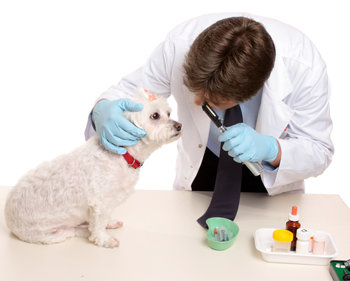Horner's Syndrome in Dogs

Horner's syndrome is a neurological problem that affects a dog's eye and the muscles of the face.
Signs of Horner's Syndrome in Dogs
Dogs suffering from Horner's syndrome usually develop signs quite suddenly, and many people fear that their dog has had a stroke when they see them. If your dog develops Horner's syndrome, the signs you see will affect one side of the dog's face and may include:
- Sagging cheek muscles
- Drooping eyelid
- Constricted pupil
- Retracted eyeball
- Prolapsed third eyelid
- Drooling
- Difficulty chewing on affected side
Causes of Canine Horner's Syndrome
The nerves that control the muscles of the face and eye travel from the brain through the spinal cord to the chest, where they exit the spine and travel back up to the ear. At that point, they attach to other nerves and continue on to the eye.
Because of this long, complicated nerve route, there are many places and ways in which interruption can occur. Some of the most common causes of Horner's Syndrome in dogs include:
- Trauma to the neck, ear, or face
- Tumor anywhere along the nerve route
- IVDD: Intervertebral Disc Disease in Dogs
- Middle ear infection or disease
- Idiopathic disease (unidentifiable cause)
Diagnosis of Horner's Syndrome in Dogs
Diagnosis of Horner's syndrome requires a thorough history and physical examination by a veterinarian. Once the syndrome is recognized and diagnosed, the doctor will be trying to determine its underlying cause. A close exam of the eyes and ears and a neurological exam will be performed at your dog's presenting visit for this condition.
Basic blood and urine tests may be done to look for obvious medical problems.
More specialized tests such as x-rays, CT scan, or MRI may be recommended based on the results of initial testing.
Treatment of Canine Horner's Syndrome
Treatment of the Horner's syndrome itself isn't necessary, but any underlying conditions that can be identified will need appropriate treatment. For example, if an ear infection is diagnosed and suspected to be the cause of the nerve dysfunction, the infection will need to be properly treated.
If no cause is found for the Horner's syndrome and it is determined to be idiopathic, as more than half of cases are, the signs may improve on their own over the following two months or so. During that time, your dog may need some symptomatic care such as softer food if he's having trouble chewing or artificial tear drops to keep his eye comfortable.
You can learn about other eye problems that dogs can develop here: "Common Eye Conditions in Dogs."
You May Also Like These Articles:
A General Guide to Puppy Safety
Canine Epilepsy: Seizures in Dogs
Restrain Your Dog While Driving
A Hidden Laundry Room Danger for Dogs: Laundry Pods
Things We Do That Annoy Our Dogs - Slideshow
Quiz - Test Your Cold Weather Dog Knowledge
Disclaimer: This website is not intended to replace professional consultation, diagnosis, or treatment by a licensed veterinarian. If you require any veterinary related advice, contact your veterinarian promptly. Information at DogHealth.com is exclusively of a general reference nature. Do not disregard veterinary advice or delay treatment as a result of accessing information at this site. Just Answer is an external service not affiliated with DogHealth.com.
Notice: Ask-a-Vet is an affiliated service for those who wish to speak with a veterinary professional about their pet's specific condition. Initially, a bot will ask questions to determine the general nature of your concern. Then, you will be transferred to a human. There is a charge for the service if you choose to connect to a veterinarian. Ask-a-Vet is not manned by the staff or owners of DogHealth.com, and the advice given should not delay or replace a visit to your veterinarian.


